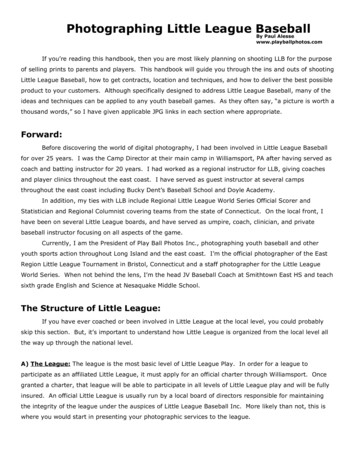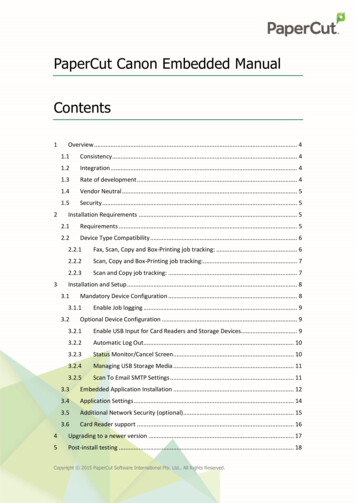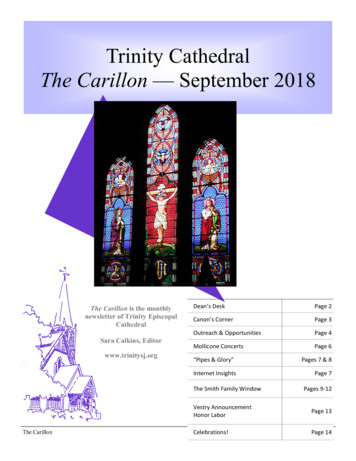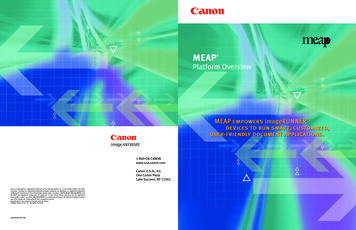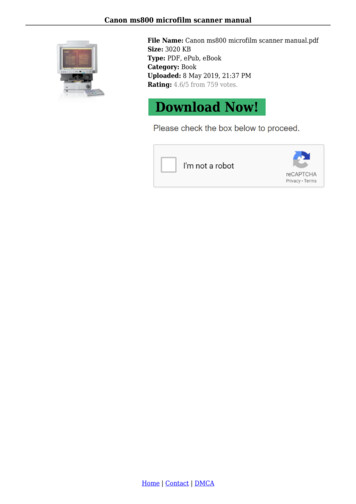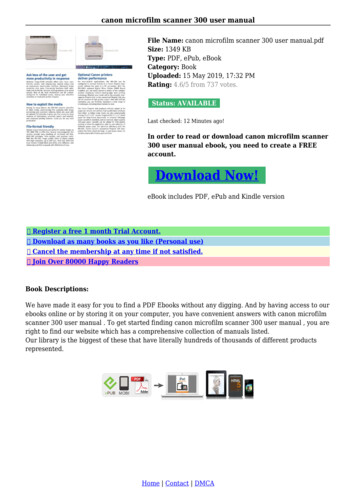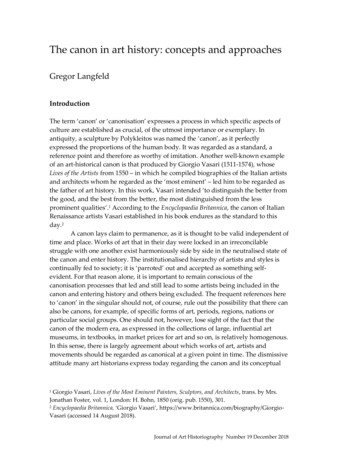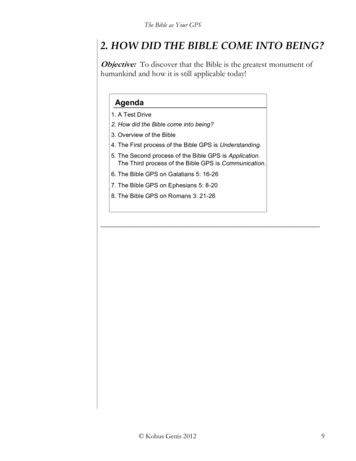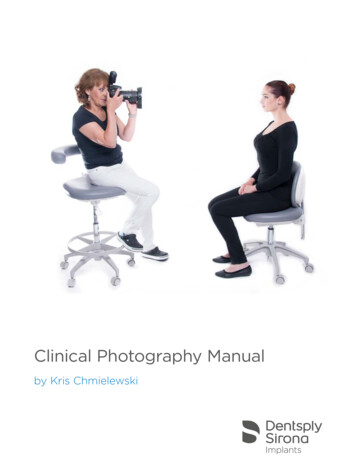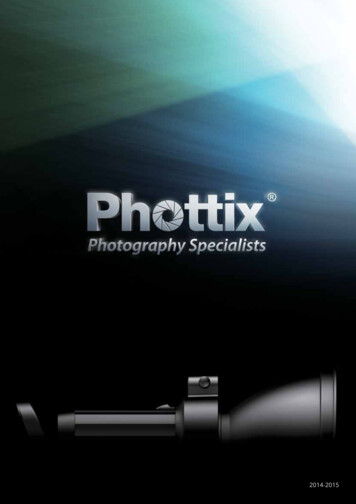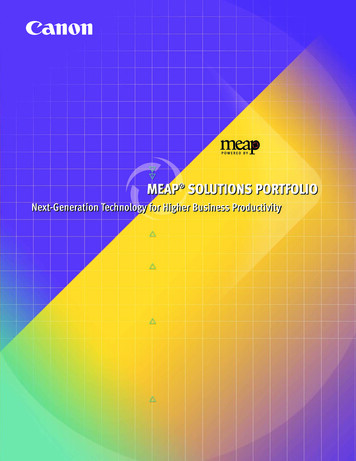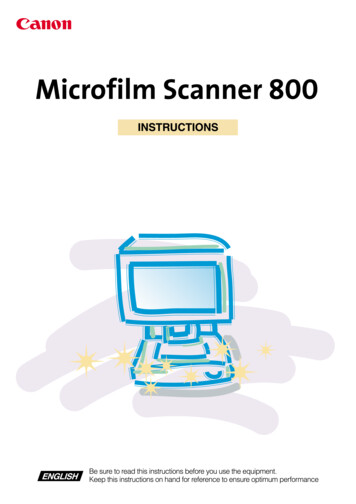
Transcription
FCC REGULATIONS (For 120V models)This equipment has been tested and found to comply with the limits for a Class A digital device, pursuant to Part 15 of the FCC Rules. Theselimits are designed to provide reasonable protection against harmful interference when the equipment is operated in a commercial environment. This equipment generates, uses, and can radiate radio frequency energy and, if not installed and used in accordance with the instructionmanual, may cause harmful interference to radio communications. Operation of this equipment in a residential area is likely to cause harmfulinterference in which case the user will be required to correct the interference at his own expense.Do not make any changes or modifications to the equipment unless otherwise specified in the manual. If such changes or modifications shouldbe made, you could be required to stop operation of the equipment.RADIO INTERFERENCE REGULATIONS (For 120V models)This digital apparatus does not exceed the Class A limits for radio noise emissions from digital apparatus as set out in the Interference-causingequipment standard entitled "Digital Apparatus", ICES-003 of the Industry Canada.RÈGLEMENT SUR LE BROUILLAGE RADIOÉLECTRIQUE (For 120V models)Cet appareil numérique respecte les limites de bruits radioélectriques applicables aux appareils numériques de Classe A prescrites dans lanorme sur le matériel brouilleur: "Appareils Numériques", NMB-003 édictée par l'Industrie Canada.Für EMNGDieses Produkt ist zum Gebrauch im Wohnbereich, Geschäfts-und Gewerbebereich sowie in Kleinbetrieben vorgesehen.NOTICECopyright 2000 by CANON ELECTRONICS INC. All rights reserved. No part of this publication may be reproduced, transmitted, storedin a system, or translated into any language or computer language in any form or by any means, electronic, mechanical, magnetic, ortical,chemical, manual, or otherwise, without the prior permission of CANON ELECTRONICS INC.The contents of this manual are subject to change without notice.Every effort has been made to ensure the accuracy of information presented in this manual. However, Canon Electronics Inc. and thesubsidiaries on the back cover assume no responsibility for any errors or their consequences.We do not assume any responsibility for damage resulting from operations regardless of item.Trademarks and Registered Trademarks Microsoft Windows and Microsoft Windows NT are registered trademark of Microsoft Corporation in the U.S. and in other countries.Kodak is a trademark of Eastman Kodak Co, of the U.S.3M is a trademark of the Minnesota Mining Manufacturing Co. of the U.S.TUSCAN is a trademark of the TUSCAN Corporation.Product names mentioned herein are for identification purposes only and may be trademarks and/or registered trademarks of theirrespective companies.
IntroductionIntroductionThank you for purchasing this Canon Microfilm Scanner800.The Microfilm Scanner 800 is a desktop universal microfilm scanner that features a large A3-format screen. Imagesprojected on the screen can be output directly to a dedicated printer connected to the scanner or downloaded asimage data onto a computer connected to the scanner.Optional carriers provide support for a wide variety of filmtypes, including roll film, microfiche and aperture cards.Read the instructions in this manual carefully to ensure thatyou make the best possible use of your scanner, and keepthis manual handy for future reference.–1–
IntroductionConventions Used in TheseInstructionsThe symbols and icons used in this manual are describedbelow. Take the time to read and understand this information before reading the rest of the manual.( 12)A number preceded by an arrow and enclosed in parentheses indicates the number of the page on which you willfind more information about the preceding statement orparagraph.WARNINGWarnings are provided for your safety and containextremely important information. Failure to observethe instructions provided in a warning could result indeath or serious injury to yourself or your co-workers.CAUTIONCaution notices are also provided for your safety andcontain important information. Failure to observe theinstructions provided in a caution notice could result inserious injury to yourself or your co-workers or damage to the equipment.IMPORTANTThese important notes contain important informationon procedures that must be followed or actions thatmust be avoided. Failure to observe a request couldresult in damage to the equipment or a malfunction.NotesNotes provide additional tips or advice that can saveyou time and effort in using the scanner.–2–
ContentsContentsIntroduction . 1Selecting the Scan Size . 26Setting the Scanning Position . 26Conventions Used in These Instructions . 2Contents . 3Before You Begin. . 4Trimming/Border settings . 27Special Features . 28Storing the Lens Magnification . 28Storing a Zoom Setting . 28Safety Notes . 4Function Keys . 29Choosing a Safe Location . 4Programming Function Keys . 29Power Supply . 6Functions that Can Be Assigned to theImportant Warnings . 7Function Keys . 30Features . 9Function Key Labels . 32Operation Modes . 10“Add on” Setting . 33Checking the Box Contents . 11Setting the Add On . 33Important Components and Their Functions . 12Setting the Caption . 35Optional Products . 13Setting the Date and Time . 36Preparing the Carrier . 14Setting the Auto Clear Time . 38Lenses . 15Fitting and Replacing Lenses . 15Preparing the Printer . 16Connecting to a Computer . 17Connecting the Computer . 17Maintenance and Troubleshooting . 39Replacing the Lamp . 39Routine Cleaning . 41Cleaning the Screen and Main Unit . 41Device Drivers . 17Using the Operation Panel Keys . 18Operation Panel . 18Operation Keyboard (optional) . 19Using the Scanner . 20Cleaning the Lens . 41Cleaning Mode . 42Cleaning the Fuser Roller . 42Troubleshooting . 43Automatic Border Removal and SkewCorrection . 44Switching On . 20User Call Errors . 45Switching Off . 20Service Call Errors . 46Loading the Film . 20Adjusting the Image . 21Focusing the Image . 21Enlarging and Reducing the Image . 22Specifications . 47Index . 48Rotating the Image . 22Printing or Scanning the Image . 23Selecting the Polarity . 23Brightness Adjustment . 24Selecting the Paper for Printing . 25–3–
Before You Begin.Before You Begin.Safety NotesTo ensure safe operation, read the following precautionsand recommendations before you choose a location and setup the scanner.;;;;;;;;;;;;;;;;;;;;;;;;150mm100mmChoosing a Safe Location To ensure adequate space for operation, maintenanceand ventilation, ensure that there is ample space aroundthe scanner on all ;;;;;;;;;;;;;;;;;;;;;;; Avoid locations exposed to direct sunlight.When direct sunlight is unavoidable, use curtains toprotect the scanner. Avoid dusty locations.Dust can adversely affect internal scanner components. Avoid locations close to taps, water heaters or humidifiers where the scanner would be exposed to high temperatures or moisture. Avoid locations affected by fumes from ammonia,acetone or other volatile chemicals. Never use any kindof volatile or flammable spray or aerosol near thescanner.–4–
Before You ;;;;;;;;;;;;;;;;;;;;;;;;;;;;;;; Never set up the scanner in locations where flammablesubstances such as alcohol, paint thinners or otherorganic solvents are present. Always set up the scanner on flat and stable surface thatcan support the weight of the scanner (47 kg). Choose a location that is free of excessive vibration. Avoid locations that are subject to extreme or suddenchanges in temperature.Condensation formed inside the scanner can adverselyaffect print quality. The temperature and humidityranges for optimum scanner operation are as follows:Temperature: 10 C to 32.5 C (50 F to 90.5 F)Humidity: 10% to 85% RH (condensation free) Do not set up the scanner close to equipment that cangenerate strong magnetic fields, such as speakers, radiosor televisions.–5–
Before You ;;;;;;;;;Power Supply Power should always be supplied from a rated poweroutlet. Do not place objects on the power cord and position thecord so that it will not be stepped on by people workingaround the scanner. Do not bundle the power cord or wrap it around objectssuch as table or chair legs. Do not attempt to unplug the scanner by pulling on thepower cord. Grasp the plug itself firmly to remove it.To ensure safe operation, always ground the scanner.Note that the scanner should never be grounded byconnecting the ground lead to a gas or water pipe.If you are unsure of any aspects of the power supply,consult your authorized Canon dealer or your powersupplier.–6–
Before You Begin.Important WarningsWARNING Always observe these warnings when using thescanner. Failure to follow these warnings couldresult in injury due to fire or electric shock. Do not set up the scanner in a location close toflammable solvents such as alcohol and paintthinners. Do not cut, damage or modify the power cord, do notpull or bend the power cord excessively, and do notplace heavy objects on the power cord. Never plug in or unplug the power cord with wethands. Do not place objects on top of the scanner as suchobjects could fall and cause injury. Do not plug thescanner into a multi-socket adapter. Do not knot or bundle the power cord, and ensurethat the plug is pushed fully into the power outlet. Use only the power cord supplied with the scanner. Do not attempt to disassemble or modify the scanner. There are no user-serviceable parts inside thescanner. Do not use flammable sprays or aerosols near thescanner. Switch the scanner off and unplug the power cordbefore cleaning the scanner. To clean the unit, use a cloth lightly dampened withwater or a mild detergent. If the scanner emits an unusual noise, odor, smoke orsparks, or if the scanner will not function whenswitched on, immediately switch the scanner off,unplug the power cord and contact an authorizedCanon dealer or service center. Before you move the scanner even a short distance,switch the scanner off and unplug the power cord.–7–
Before You Begin.CAUTIONS Do not set up the scanner on sloping, wobbly orotherwise unstable surfaces or in locations affectedby excessive vibration. The scanner could causeinjury if it falls over or slides off the surface. Do not block the ventilation slots as this could resultin a fire due to the build up of heat inside the scanner. Do not place vessels containing liquids (cups, vases,etc.) or small metal objects (paper clips, staples,necklaces, etc.) on top of the scanner. Liquids ormetal objects falling into the scanner could cause anelectric shock or fire. If any liquids or metal objectsfall into the scanner, immediately switch the scanneroff, unplug the power cord and contact an authorized Canon dealer or service center. Do not set up the scanner in dusty or humidlocations as this could result in an electric shock orfire. Do not place heavy objects on top of the scanner assuch objects could fall and cause injury. Use only a power supply having the rated voltage.The use of other voltages could result in a fire orelectric shock. Always unplug the power cord by grasping the plugitself. Pulling on the power cord can damage thecord so that the core wires are exposed or snappedand could cause a fire or electric shock. Do not use an extension power cord as this couldcause a fire or electric shock. Keep the area around the power outlet free of obstacles to ensure that the scanner can be unpluggedquickly in the event of an emergency. Take care not to tip water or flammable solventssuch as alcohol, thinners or benzene into the scanneras this could result in a fire or electric shock. If the scanner will be left unused for a lengthyperiod, always unplug the scanner as a safety measure. Avoid touching internal scanner components whenyou perform routine cleaning or maintenance suchas changing the lamp. Some internal componentsgenerate high temperatures or high voltages. Toavoid injury such as burns or electric shocks, takecare also that metal objects such as necklaces orbracelets do not come into contact with internalscanner components. To avoid injury when you are moving the scanner,take care not to put your hands on the metalprotrusions on the underside of the scanner unit.–8–
Before You Begin.FeaturesThe Canon Microfilm Scanner 800 features the following: Large-format screen, small footprintDespite providing a large A3-size screen, this compactuniversal microfilm scanner is small enough to fit on adesktop. Automatic film selectionThe scanner’s automatic film polarity detection functionsaves you the trouble of switching the polarity whenyou are scanning both negative and positive film. Support for different film formatsWith its wide range of optional roll carriers, fichecarriers and Auto Carriers, this scanner can handle awide variety of film formats, including microfiche,aperture cards and roll film. Automated and motorized operationSimple keystrokes can be used to control editing functions such as screen image adjustment and borderremoval as well as other scanner functions. Different operation modes to suit your circumstancesThe MS800 scanner has 2 operation modes:“ReaderPrinter mode”, in which the image on the screenis sent directly to a dedicated printer, and “Scannermode”, in which the scanner is connected to a personalcomputer and the scanned image data is downloaded tothe computer. You can select whichever mode best suitsyour needs. The operation mode is set by the servicetechnician at installation. See “Operation Modes” onP.10 for more information.–9–
Operation ModesThe MS800 scanner has 2 operation modes: “Reader/Printer mode”, in which the image on thescreen is sent directly to a dedicated printer, and “Scanner mode”, in which the scanner is connectedto a personal computer and the scanned image data is downloaded to the computer to be printed ona printer connected to the computer. The connected devices and operation procedures for the twomodes differ. Select the mode that best matches your system setup.The operation mode is set by the service technician at installation. Contact your authorized Canonservice representative for details. Reader/Printer modeThis configuration consists of the Microfilm Scanner 800 with a FilePrint 400 printer. Screen images are sentdirectly to the FilePrint 400 using the control panel on the Microfilm Scanner 800. To switch from this modeto Scanner mode, contact your Canon service technician.PrintFile Print 400Microfilm Scanner 800 Scanner modeThis configuration consists of the Microfilm Scanner 800 with a computer and printer. Application software isused to download screen images to the computer connected to the Microfilm Scanner 800 as image data. Thedownloaded image data can then be sent to the printer connected to the computer. To switch from this mode toReaderPrinter mode, contact your Canon service technician.PrintPicture detaComputerPrinterMicrofilm Scanner 800 Reader/Printer/Scanner mode (factory default):Select this mode when you want to use both Reader/Printer mode and Scanner mode. You switchbetween the two modes by assigning a switching function to one of the function keys. This modealso allows you to use the MS 800 as a scanner in Reader/Printer mode and scan images fromyour computer. However, you should switch to Scanner when you want to scan from the computer since some scanner keys cannot be used in Reader/Printer mode.Reader Printer modePrintScanner modePicture detaPrintComputerFilePrint 400Microfilm Scanner 800– 10 –(Printer)
Before You Begin.Checking the Box ContentsThe Microfilm Scanner 800 package contains the items listed below. If any of these items is missing, contact your Canon service outlet for assistance.Microfilm Scanner 800INSTRUCTIOLens holderNSINSTRUCTIONSINSTRUCTIONSENGLISHBe sureKeep thisto read thisinstruction instructions on hand s beforeyou usefor referencetheto ensureequipment.optimumperformanceENGLISHBe suretoKeep this read this instructionsinstructionson hand before you usefor referencethe equipment.to ensureoptimumperformanceMicrofilm Scanner 800InstructionsScanning Utility 800InstructionsISIS/TWAIN DriverInstructionsSetup CD-ROMSoftware LicenceAgreementWarranty CardFunction key labelsPower cord– 11 –(USA and Canada only)
Before You Begin.Important Components and Their FunctionsTake a few moments to familiarize yourself with the names and functions of the main componentsof the scanner, as described below.1283497651 ScreenShows enlarged projections of the images onthe microfilm.7 DIN connectorUse this socket to connect a motorized carrier(optional).2 Framing Kit (optional)When a specified area is to be scanned, usethis cursor to set the size of the scanned area.8 Operation panelUse these buttons to specify the image adjustment and operation mode settings.3 Lens holderHolds the lens.9 Operation keyboard (optional)Provides easy access to all the operation panelcontrols.4 Lamp unitHolds the lamp that illuminates the image.Remove this unit to change the lamp.!º Foot switch (optional)An underfoot switch that provides the samefunction as the Start key on the operationpanel.5 Carrier padHolds the film carrier.6 Power switchSwitches the scanner on and off.– 12 –
Before You Begin.Optional ProductsIn addition to the accessories provided in the productpackage, a number of optional accessories that are requiredfor using the scanner, such as carriers and lenses, are alsosold, as well as other optional accessories that can bepurchased as needed. Contact your nearest authorizedCanon Dealer for details.Carriers ( 13 “Preparing the Carrier”)Carriers can be used for all types of film, including cartridge film, microfiche, jacket film and aperture cards.Because the scanner does not come with a carrier, purchasethe carrier best suited to your needs.Installation Kit ( 13 “Preparing the Carrier”)Some carriers require the Installation Kit. Contact yournearest authorized Canon service outlet for details.Lenses ( 14 “Lenses”)One fixed-focus lens and four zoom lenses are provided forthe MS 800. Because the scanner does not come with alens, purchase the lenses best suited to your needs.Framing Kit ( 25 “Trimming/Border settings”)This unit allows you to select a part of the image projectedonto the scanner screen (trimming). This Framing Kit isrequired in order to use the Trimming function provided inthe scanner.Operation Keyboard ( 16 “Using the OperationPanel Keys”)This keyboard provides a handy way to access the functions provided on the operation panel.Foot SwitchThis is an underfoot switch that provides the same functionas the Start key on the operation panel.128MB Additional MemoryTo scan in grayscale mode from the application softwareadditional memory must be installed in the scanner.Contact your nearest authorized Canon Dealer for details.FilePrint 400 ( P.15 “Preparing the Printer”)A dedicated printer for the Microfilm Scanner 800 when itis used in Reader Printer mode.– 13 –
Before You Begin.Preparing the CarrierThe list below shows all the optional film carriers that canbe installed on the Canon Microfilm Scanner 800. Formore details about these optional carriers, consult yourCanon dealer or authorized Canon service outlet. Forinformation on carrier installation and operation, refer tothe instructions provided with the carrier.NoteThe Auto Carrier 100C, 100M and 100R and the FSController I and Roll/Fiche Carrier 200 require theoptional installation kit.Fiche Carrier 190R IIA film carrier for viewing microfiche (up to 105 x 190mm), jackets and aperture cards.Auto Carrier 100C (AC100C)A motorized automatic carrier for 16 mm cartridge film(ANSI, ANSI ENCLOSED *1, Kodak Ektamate or 3M)that features high-speed automatic loading and rapid filmfeeding and display.Auto Carrier 100M (AC100M)A motorized automatic carrier for 3M cartridges orTUSCAN M-type *2 cartridges that features high-speedautomatic loading and rapid film feeding and display.Auto Carrier 100R (AC100R)A motorized automatic carrier for 16 or 35 mm film woundon standard open reels.FS Controller IA motorized automatic carrier for 16 mm cartridge film(ANSI, Kodak Ektamate or 3M). This carrier is requiredfor reading film marked with blips for image search andretrieval.FS Controller IIIA motorized automatic carrier for the latest 16 mm cartridge film (ANSI, Kodak Ektamate or 3M). This carrier isrequired for reading film marked with blips for imagesearch and retrieval.Roll/Fiche Carrier 200This carrier is required for reading 16 or 35 mm standardopen reel film, 16 mm cartridge film (ANSI, KodakEktamate or 3M), microfiche (up to 105 x 190 mm),jackets or aperture cards.*1 ANSI ENCLOSED cartridges are as stipulated in ANSI MS-15.*2 TUSCAN M-type refers to TUSCAN cartridges with a 3M-type core.– 14 –
Before You Begin.LensesThe types of lenses that can be used with this scanner aredescribed below.Fixed-focus LensesGZ X57 (57x)Zoom LensesGZ X7-X7.5 (7x to 7.5x)GZ X9-X16 (9x to 16x)GZ X14-X30 (14x to 30x)GZ X20-X50 (20x to 50x)Fitting and Replacing LensesUse the procedure below to fit or change the lens.1 Grasp the lens holder firmly and slide it out of the lensholder bracket.2 If a lens is already fitted in the holder, use one hand tosupport the base of the lens holder, taking care to ensurethat the lens does not fall out.– 15 –
Before You Begin.4 Slowly set the lens in the lens holder.IMPORTANTWhen you are fitting a zoom lens, check that the 2marks on the rim of the lens are matched with thecontacts on the lens holder. These contacts must bealigned snugly for the scanner to correctly recognizethe zoom lens type. Take care also not to touch thecontacts with your fingers.5 Slide the lens holder back into the main unit, taking carenot to drop the lens.Push the holder slowly into the bracket until you hear itclick into place.Preparing the PrinterTo use the Microfilm Scanner 800 in ReaderPrinter mode,a Canon FilePrint 400 printer (sold separately) is required.Contact an authorized Canon retailer or service technicianfor details.NOTECanon FilePrint 400Refer to the FilePrint 400 Instructions for information on setting up the printer.– 16 –
Connecting to a ComputerTo use the Microfilm Scanner 800 in Scanner mode, youwill need the following equipment in addition to theaccessories provided with the scanner: Computer SCSI card SCSI cableIMPORTANTNo SCSI cable is supplied with the scanner. Toconnect the scanner to a computer, obtain a SCSIcable with the correct connectors for the scanner andthe SCSI card installed in the computer. The SCSIconnector on the scanner is a half-pitch 50-pinconnector (pin-type).Connecting the ComputerConnection of the SCSI cable to the main unit and thespecification of the SCSI ID and other settings should bedone by the supervising service personnel. To change theSCSI ID or any other connection settings, contact theservice person.NoteAt shipment, the SCSI ID for the scanner is set to 2and the terminator setting is OFF.Device DriversIf the computer is running the Windows 95/98, a screenrequesting installation of the scanner driver (“New Hardware” or “Device Driver Wizard”) will appear the firsttime you switch the computer on after connecting thescanner to the computer. In the “New Hardware” screen,choose “Select from list” and click “OK”. In the nextscreen, select “Other devices” and click “OK”.In the “Device Driver Wizard” screen, click “Next” andthen click “Completed” in the next screen.– 17 –
Before You Begin.Using the Operation Panel KeysOperation PanelM1F1F2M2F4F5ZOOMF3F6AEM3AFFOCUSROTATE1 Function keysSettings such as printing or scanning parameters andoperation modes can be stored in a function key and thestored operation mode recalled instantly simply by pressing the function key. Settings are stored in a function keyusing the application software or by programming thefunction key ( P.29).2 Negative/Positive keySelects one of three modes: Positive prints from negativefilm, positive prints from positive film, or automatic filmpolarity detection.3 Trimming/Border keyWhen scanning or printing, use this key to trim part of theimage or to remove the black border around the image.4 Scanning Position keyUsed to specify whether the reference position for scanningor printing is the center of the screen or the left edge. Thiskey is also used to specify scanning of 2 consecutivepages.5 Paper Select/Scan Size keyIn Reader Printer mode, this key selects the paper size usedfor printing. In Scanner mode, this key selects the scansize.6 Brightness indicatorShows the brightness adjustment set using the Brightnesskeys or the setting for adjustments such as the margin sizeor sharpness.7 Brightness adjustment keysThe and keys are used to manually adjust the brightness of the printed or scanned image. The AE key specifiesautomatic adjustment.8 Error/User Mode displayDisplays an error message (user call or service call) or theselected user mode. This display also shows the number ofcopies in ReaderPrinter mode.9 User Mode keysSelects the user mode and can be used to set the number ofcopies in ReaderPrinter mode.!º Clear/Stop keyUsed to stop scanning or printing and to change the usermode setting.!¡ Start keyIn Reader Printer mode, the Start key starts printing. InScanner mode, this key starts a scan in Semi-Auto mode.! Preset Zoom keysThese keys are used to store the magnification settings forzoom or fixed-focus lenses and to automatically adjust thescanner to the stored magnification.– 18 –
Before You Begin.! AF (Auto Focus) keyUsed to automatically focus the image.! ZOOM (enlarge/reduce) keyUsed to enlarge or reduce the size of the image projectedon the screen. Press the ZOOM key and then use thecontrol knob to enlarge and reduce the image on the screen.FOCUS keyAdjusts the focus of the image projected on the screen.Press the FOCUS button and then turn the control knobuntil the image on the screen is in focus.!§ ROTATE keyRotates the image projected on the screen. Press theROTATE key and then turn the control knob. The imagerotates to match the rotation of the control knob.!¶ Control knobTurn this knob to adjust the image after the ZOOM, FOCUS or ROTATE key has been pressed.Operation Keyboard (optional)P2P3P4! Image adjust selection keySelects the image adjustment mode (zoom, focus or rotate).!ª Image adjust mode indicatorsThese indicators show the image adjustment mode selectedusing key ! .@º Image adjust control dialAfter selecting the image adjustment mode, turn this dial toadjust the image.@¡ Rotate keyRotates the image 90 clockwise or counterclockwise.@ Film control knobWhen a motorized carrier is installed, this knob feedsthrough the film. Turn the knob to the right to advance thefilm and to the left to rewind the film. (Note that this knobcannot be used with the FS Controller I or III.)@ RESET keyRestores the default settings for each setting mode.@ Paper Select keySelects the paper cassette or multipurpose tray inReaderPrinter mode.Disabled keyNot used by the MS800.– 19 –
Using the ScannerUsing the ScannerSwitching OnUse the procedure below to switch the scanner on.IMPORTANTIf an FS Controller III is installed on the scanner,switch the FS Controller III on first.1 Press the “ ” side of the power switch to turn on themain unit. When the main unit is switched on,
Thank you for purchasing this Canon Microfilm Scanner 800. The Microfilm Scanner 800 is a desktop universal micro-film scanner that features a large A3-format screen. Images projected on the screen can be output directly to a dedi-cated printer connected to the scanner or downloaded as image data onto a computer connected to the scanner.
